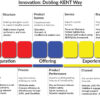
In the past few years, “artificial intelligence” is no longer just a niche area but is at the center of what is being characterized as a “race for investment” around the world. Governments, giant tech enterprises, and high-growth companies have channelled hundreds of billions of dollars into data centers, semiconductors, and products relating to AI because they all firmly believe this technology will “disrupt” all industries. But now, opinions seem to have changed because warning signs for an “AI bubble” are emerging.
This does not mean AI itself is a fad. What it means is maybe the projected monetary expectations associated with AI may be beyond what is truly possible.
What is meant by “imminent AI bubble burst”?
A bubble takes place where prices and investments go beyond what is warranted by fundamentals. Three areas are causing alarm for regulators and investors in AI:
– Soaring valuations: While valuations regarding AI-related stocks have been considered “stretched” by the Bank of England, warning that market correction became “more likely,” they liken this cycle to “the dotcom peak experience.”
– Speculative Funding: OpenAI CEO Sam Altman admitted, “Yes, we are in an AI bubble,” because investors are “overexcited about a kernel of truth” as seen in past speculative episodes.
– Macro consideration: This is confirmed by IMF observations: “Risk asset prices, particularly mega cap equities influenced by AI, remain well above fundamentals, posing a risk of sharp correction should expectations falter.”
In India, for example, Sridhar Vembu, CEO of Zoho Corporation, has referred to “financial bubble” investments being put into current AI efforts because of “extreme valuations” and round-tripping of investments, noting: “We may end up destroying our own future by such investments!”
Put simply: The world has put big stakes on AI’s pace and its profitability and may experience severe repricing if this pace is not achieved.
Upside to business from AI boom (pre-burst and post-burst scenarios)
Despite the acceptance of the existence of a bubble, many positives have resulted from the boom of AI:
It has also spurred innovation at faster rates than before. With trillions of dollars’ worth of investments being planned for spending on data centers and semiconductors, it is helping create infrastructure for the digital age that will last beyond the current hype cycle, just like how investments in fiber optic cables helped create the infrastructure needed for today’s online economy during the dot com bubble.
Second, it is associated with experimentation. According to data from Deloitte for 2025, most large enterprises are exploring investments in AI and generative AI while admitting that they will take at least one or two years to overcome barriers associated with ROI and adoption for such processes.
This experimentation is not perfect but is needed and provides the foundation for skills that will no longer be experimental within the next decade.
Thirdly, bubbles tend to bring about the future faster than expected. As noted by Jeff Bezos recently relating to AI: “We’re already in an industrial bubble right now…. It is kind of like e-commerce 10-15 years ago: lots of ideas getting lots of money for things that will fail but also lots of things that will change industries entirely.” This is also applicable in this case.
The negative: why a burst may cause harm
Yet the dangers are very real:
Misallocation of capital: “A paradox of growing investment and elusive returns” is what Deloitte sees: “Boards continue to increase AI budgets without obvious or scalable use cases to deliver business outcomes.” This looks like means to fund pilots and PoCs instead of worthwhile initiatives.
Systemic Risk to Markets: Given the preponderance of tech stocks affected by AI to leading market indexes, both the IMF and the Bank of England warn of a sharp market correction should sentiment swing against AI.
Innovation whiplash: A bust follows because investors tend to overcorrect. A promising but unglamorous project related to AI in areas such as manufacture, agriculture, or health may lack funding simply because anything associated with “AI” is now considered high-risk to investment committees.
This is “too much irrigation for shallow roots” to paraphrase from an Indian perspective. It appears to have green foliage near the top but may lack solid business roots to weather any drought just yet.
Impact on Healthcare: Hype vs. Healing
Healthcare is one domain very largely targeted for investment and adoption of AI, but it is also at risk if the hype generated is not sustained.
On the Positive Side:
There is definite progress being made regarding AI applications in health care. The present estimate for the AI market for health care at the global level for 2024 is between US$26 and US$32 billion, potentially growing to beyond tenfold by the next decade.
According to surveys conducted by Deloitte for 2024 and 2025, most current hospital systems utilize some means of AI for business workflows or patient care, and most leaders have or expect a good ROI for generative AI solutions.
Concrete examples include:
– AI-enabled imaging software for diagnosing stroke and cancer earlier, with 300+ FDA-approved AI software being used to some extent.
– Automation of documentation and coding to reduce clinician burnout and facilitate faster reimbursement.
But the one area which shows limitations of hype is: Healthcare
In real-life implementations, progress is held back by data fragmentation, regulation requirements, task workflow integration, and clinician trust. Data quality and bias have been shown to strongly act as barriers to implementation, even for enthusiastic executive support.
Many health information systems struggle to show overall cost effectiveness after cloud spending is taken into consideration.
If the AI bubble bursts:
On the one hand: Hospitals and policymakers may become more disciplined now. Only initiatives relating to better outcomes or error reduction or time-saving for hospital staff will remain. Cosmetic chatbots or “AI for AI’s sake” projects will become obsolete.
The bad news is that early-stage, high-impact innovations – say, AI-driven decision-support for rural primary care in India – might lose funding right when they need patient capital and rigorous trials.
Internationally, Sam Altman’s warning is relevant to healthcare as well: “When bubbles happen, smart people get overexcited about a kernel of truth.”
Corresponding from India is Sridhar Vembu’s measured approach to highly valued companies and speculation surrounding AI investments, bringing to mind for many why AI really should improve patient experience by not being squandered on hype.
Navigating the Bubble: A Pragmatic Perspective
What should business and healthcare leaders do faced with conversations about an impending AI bubble bursting?
Break down technology and assessment into separate concepts. The role of artificial intelligence may persist as an overarching general-purpose technology regardless of changes in market values. The focus of long-term strategic planning must be placed upon long-term capability development and not necessarily today’s market exuberance or worries.
The need to apply disciplined use cases. Going along with Deloitte’s findings, organizations that succeed with AI start with sound business objectives, AI competency, and rigorous measures in assessing outcomes.
Prepare for turbulence, not disaster. A market correction will inevitably hurt those with high leverage and overhype. But those with strong balance sheets and grounded outlooks can indeed capitalize on this time to poach talent, pick up assets, and make serious investments in innovations at lower prices.
The comment by Jeff Bezos captures the right balance, which is that “the AI bubble might very well be an industrial bubble,” but AI “is about to revolutionize every industry.”
For leaders, especially in high-stakes sectors such as healthcare, the agenda is to manage this transition and keep their centripetal force intact, i.e., recognize and capitalize on AI’s potential, alongside staying grounded in their realities.
Dr. Prahlada N.B
MBBS (JJMMC), MS (PGIMER, Chandigarh).
MBA in Healthcare & Hospital Management (BITS, Pilani),
Postgraduate Certificate in Technology Leadership and Innovation (MIT, USA)
Executive Programme in Strategic Management (IIM, Lucknow)
Senior Management Programme in Healthcare Management (IIM, Kozhikode)
Advanced Certificate in AI for Digital Health and Imaging Program (IISc, Bengaluru).
Senior Professor and former Head,
Department of ENT-Head & Neck Surgery, Skull Base Surgery, Cochlear Implant Surgery.
Basaveshwara Medical College & Hospital, Chitradurga, Karnataka, India.
My Vision: I don’t want to be a genius. I want to be a person with a bundle of experience.
My Mission: Help others achieve their life’s objectives in my presence or absence!
My Values: Creating value for others.
References
- Kollewe J. Bank of England warns of growing risk that AI bubble could burst. The Guardian. 2025 Oct 8.
- Heath A. Sam Altman says we are in an AI bubble. The Verge. 2025 Jun 3.
- International Monetary Fund. Global Financial Stability Report: Market Risks and Sectoral Vulnerabilities. Washington, DC: IMF; 2025.
- The Times of India. Zoho founder Sridhar Vembu warns: “This boom makes me very uncomfortable…” Times of India – Tech News. 2025 Apr 10.
- Reuters. Jeff Bezos says AI boom is an “industrial bubble” but will transform every industry. Reuters Technology. 2025 Nov 14.
- Deloitte. State of Generative AI in the Enterprise: 2025 Global Report. Deloitte Insights; 2025.
- Deloitte. The AI Investment Paradox: Rising Spend and Elusive ROI. Deloitte Insights; 2024.
- Reuters. Big Tech’s trillion-dollar AI data-centre buildout accelerates global infrastructure boom. Reuters Technology. 2025 Oct 29.
- Deloitte. AI in Healthcare: Adoption, Challenges and ROI Insights 2024–2025. Deloitte Insights; 2025.
- MarketsandMarkets. AI in Healthcare Market by Offering, Technology, Application – Global Forecast to 2030. MarketsandMarkets; 2024.
- Healthcare Information and Management Systems Society (HIMSS). AI in Clinical Operations: Documentation, Coding and Workflow Automation Trends. HIMSS Report; 2024.
- McKinsey & Company. Overcoming Data Quality and Integration Barriers in Healthcare AI. McKinsey Digital Health; 2024.
- Gartner. AI Cost, Cloud Expenditure and ROI Challenges: Global Enterprise Survey 2025. Gartner Research; 2025.

















Leave a reply